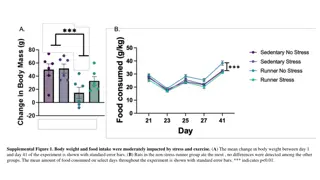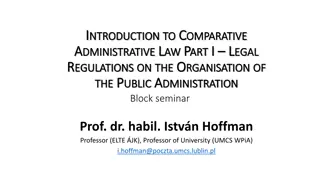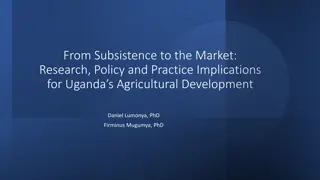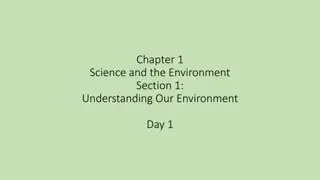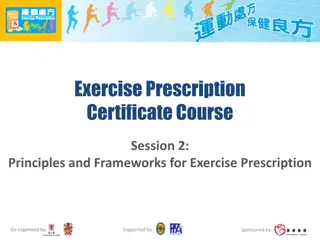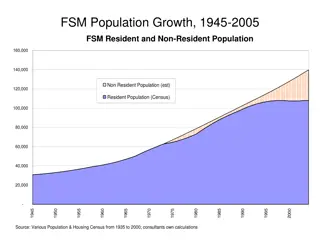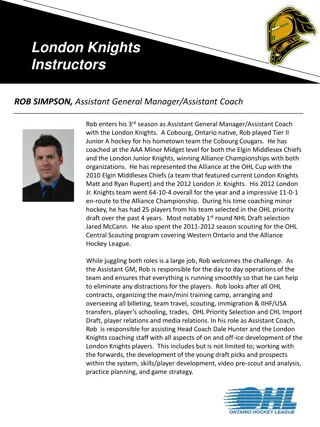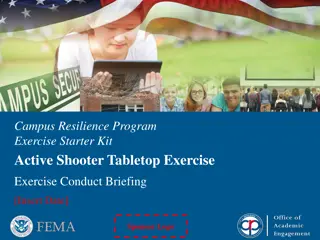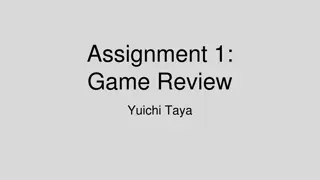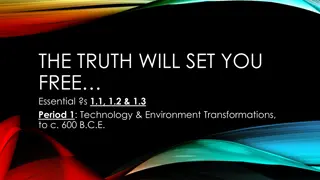Hunter-Gatherer Subsistence Systems Comparison Exercise
Explore social factors related to hunter-gatherer subsistence systems through group analysis, data collection, and pattern observation. Understand the societal impact of food collection on various aspects of life, with a focus on hunting and gathering societies. Utilize teaching resources from Yale University to enhance learning outcomes and historical understanding of hunter-gatherer lifestyles.
Download Presentation

Please find below an Image/Link to download the presentation.
The content on the website is provided AS IS for your information and personal use only. It may not be sold, licensed, or shared on other websites without obtaining consent from the author.If you encounter any issues during the download, it is possible that the publisher has removed the file from their server.
You are allowed to download the files provided on this website for personal or commercial use, subject to the condition that they are used lawfully. All files are the property of their respective owners.
The content on the website is provided AS IS for your information and personal use only. It may not be sold, licensed, or shared on other websites without obtaining consent from the author.
E N D
Presentation Transcript
SUBSISTENCE Hunter-GathererExercise Adapted from Teaching eHRAF Exercise 1.22 Hunter-Gatherers, Level I. by Carol Ember.
Fresh meat cut from bone. Photo by Jon Sullivan. Public Domain Image via WikimediaCommons. In this exercise students will break into groups and compare and contrast the various social factors correlated with hunter gatherer subsistence systems. HUNTER-GATHERER SOCIAL COMPARISONS
EXERCISE DETAILS TIME: 45 minutes MATERIALS REQUIRED: Worksheet and pen or other materials for recording answers 6 person working groups STUDENT LEARNING OUTCOMES: At the end of this assignment,youwill be able to: observe and analyze patterns of social life using the example of hunting and gathering societies gain experience in team based secondary data collection and analysis techniques construct effective and efficient search strategies in eHRAF in order to retrieve data relevant to a specific topic/assignment. This Teaching Exercise is provided by the Human Relations Area Files at Yale University in New Haven, CT
VARIATION IN HUNTER GATHERERS By understanding what conditions predict variation and also using the paleoanthropological record to make educated guesses about past conditions in a particular place, anthropologists may have a better chance of inferring what hunter-gatherers of the past were like (Hitchcock and Beisele 2000, 5; C. R. Ember 1978; Marlowe 2005). Ilongot hunting party. Popular Science Monthly Volume 77. 1910. Public Domain Image via WikimediaCommons This Teaching Exercise is provided by the Human Relations Area Files at Yale University in New Haven, CT
The Alaskan Range. United States geologicalSurvey. Public Domain Image via WikimediaCommons MAIN QUESTION The way a society gets itsfood seems to affect many aspects ofsocialand political life. What arethe societal living conditions like forpeople who make their living fromwild food resources (food collectors)? This Teaching Exercise is provided by the Human Relations Area Files at Yale University in New Haven, CT
This Teaching Exercise is provided by the Human Relations Area Files at Yale University in New Haven, CT ASSIGNMENT PART 1 Break into groups of six and evenlydividethe societies onthe following slide among all groupmembers. Hadza archeryandhunters, Lake Eyasi,Tanzania.2008. Photo byWoodlouse.CCby2.0 Via Wikimedia Commons
HUNTER GATHERER GROUPS Dividethefollowingculturesamongyourgroupmembers.Haveeachmemberexplorethe CulturalSummariesforthefollowinggroups,usingthe"BrowsebyCultures"taboneHRAF WorldCultures,inordertolocateanswerstothequestionsonthefollowingpage. Quinault Aleut Warao Bororo Tlingit Alutiiq Tubatulabal Xokleng Chipewyans Yokuts Abip n Copper Inuit Yuki Chorote Ingalik Yurok Ona Innu Assiniboine Tehuelch Kaska Blackfoot e Aranda Ojibwa Comanche Western Woods Cree Crow Tiwi Mi'kmaq Chinookans of the Lower Columbia River Manus Haida This Teaching Exercise is provided by the Human Relations Area Files at Yale University in New Haven, CT
ASSIGNMENT PART 1 Each individual will fill in the following data table for their chosen society(s): **Locate this information in the Cultural Summaries for each Culture, which can be found via Browse Cultures at eHRAF World Cultures** Society Name Response Settlement size (Large 100+/Medium 50-99/Small <50) Degree of settlement permanence (Permanent/Temporary) Total population size (use demography)
ASSIGNMENT PART 1 Regroup and combine individual findings into a large group table (5 minutes). Society A Society B Society C Society D Society E Society F Settlement size Degree of settlement permanence Population Size
ASSIGNMENT PART 2 Using the group table, calculate what percentage of hunting and gathering societies have Large settlements Medium settlements Small settlements Permanentsettlements Nomadic settlements Hopi Indian boypretendingto use a bow andarrowagainsta Hopi Indian girl, ca.1901. She is standing to the left of the doorway of an adobe dwelling. Photo by Pierce, C.C.Public Domain Image via Wikimedia Commons This Teaching Exercise is provided by the Human Relations Area Files at Yale University in New Haven, CT
ASSIGNMENT PART 3 Answer the following questions in yourgroups. 1. What patterns do you observe, now that you have combined all this data? E.g. What tendencies towards social factors? Number these tendencies and summarize them. (appx. 5 minutes) 2. Formulate each of these tendencies as a hypothesis and briefly describe how you would go about testing it (appx. 8 minutes) 3. Were there any societies that didn t fit the patterns you noticed? (appx. 7 minutes) This Teaching Exercise is provided by the Human Relations Area Files at Yale University in New Haven, CT
This Teaching Exercise is provided by the Human Relations Area Files at Yale University in New Haven, CT RESOURCES Assignment Rubric, Tips,References The KhomaniSan Craft Village, connectedwith !Xaus lodge, where membersof the communityshow their traditionalskills. Kgalagadi Transfrontier Park. by Tim Ellis CC by 4.0 viaFlickr
This Teaching Exercise is provided by the Human Relations Area Files at Yale University in New Haven, CT RUBRIC The following rubric is suggested for evaluating responses: Unsatisfactory (0%) (25%) NeedsImprovement Satisfacto ry (75% Outstandi ng (100%) Needs Improvement Satisfactory Outstanding Assignment Part 1: Tables Unsatisfactory Tables for hunter-gatherer societies include multiple societies with regular notes Tables for hunter-gatherer societies include multiple societies with a variety of notes and most include citations. Tables for hunter-gatherer societies are sparsely filled in and include only a few (2-3) societies. Tables for hunter-gatherer societies in eHRAF are absent Satisfactory Unsatisfactory Assignment Part 2: Calculations Needs Improvement Outstanding Answers are largely complete and mostly accurate Answers are absent or mostly incomplete Answers are complete and accurately calculated. Answers are only partially completed and/or inaccurate Needs Improvement Satisfactory Outstanding Commentary on research findings is not comprehensive and /or persuasive. Evaluation and analysis of research findings is accurate. Major points are stated. Assignment Part 2: Questions 1-3 Evaluation and analysis of research findings is accurate and persuasive. Hypotheses are stated clearly Responses are excellent and address questions Content is clear. Several specific examples from the research are used. Unsatisfactory Major points are addressed, but not well supported. Responses are inadequate or do not address topic or response to the questions Specific hypothesis do not support topic or response to the questions. Major points are not clear. Specific examples are not used. Hypotheses not present Hypotheses are adequate and would address the question at hand. Content is accurate A specific example from the research is used.
FURTHER READING For more exercises and teaching resources related to human societies past and present, explore Teaching eHRAF. For more information on Hunter-gatherers check out the Hunter-Gatherermodule by Carol Ember in HRAF s Explaining Human Culture database. For a more detailed version of this particular exercise with additional questions and activities check out Teaching eHRAF Exercise 1.22 Hunter-Gatherers, Level I. by Carol Ember. For information on hunter-gatherers in the archaeological record, check out eHRAF Archaeology. This Teaching Exercise is provided by the Human Relations Area Files at Yale University in New Haven, CT
REFERENCES Hitchcock, Robert K., and Megan Beisele. 2000. Introduction. In Hunters and Gatherers in the Modern World: Conflict, Resistance, and Self-Determinations, 1 10. New York, NY: Berghahn Books. Ember, Carol R. 1978. Myths About Hunter-Gatherers. Ethnology 17 (4): 439 48. doi: 10.2307/3773193. Marlowe, Frank W. 2005. Hunter-Gatherers and Human Evolution. Evolutionary Anthropology: Issues, News, and Reviews 14 (2): 56 67. doi:10.1002/evan.20046.





